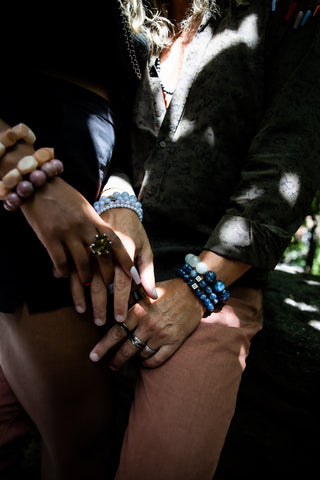For a long time, jewelry has been split into two categories: fine and costume. On one end, you have fine jewelry—gold, platinum, diamonds, and precious stones, often priced out of reach for everyday wear. On the other, you have costume jewelry—affordable, trendy, but typically made of cheap metals and imitation stones that tarnish, fade, or fall apart after a few wears. But in recent years, a new category has emerged: lifestyle jewelry. It’s not just a compromise—it’s a category in its own right.
What Is Lifestyle Jewelry?
Lifestyle jewelry sits right in the middle. It’s designed for daily wear, crafted with durable, sustainable materials, and often features semi-precious gemstones. It’s affordable without being disposable. It’s quality without the markup. Think sterling silver that doesn’t turn your skin green. Gold vermeil that lasts. Natural stones like moonstone, topaz, citrine, or garnet—set in well-designed, tarnish-resistant pieces that look good without screaming “costume.”
This type of jewelry isn’t about status or trends. It’s about personal expression and function. It’s designed to move with you—whether you’re at work, out with friends, or traveling. You don’t have to take it off at night. You don’t have to baby it. It fits your life, and enhances your look, without the stress or financial pressure of “real” fine jewelry.
The Rise of the Middle Market
Why now? A few reasons.
First, consumers are more conscious. We want transparency about materials. We care about sustainability. We want products that align with our values—not just in how they look, but in how they’re made.
Second, the rise of direct-to-consumer brands has cut out the middlemen. That means better quality at lower prices. You no longer need to spend thousands to get a well-made piece that lasts.
Third, fashion itself has changed. Style is less about formality, and more about ease. People are mixing high and low, vintage and new, bold and minimal. Jewelry has followed suit. It’s no longer locked into occasion or tradition. It’s fluid. That’s where lifestyle jewelry shines.
Materials That Make the Difference
What separates lifestyle jewelry from costume jewelry is what goes into it. The materials matter:
• Sterling silver: An alloy of 92.5% silver, it’s durable, polishable, and naturally hypoallergenic. It’s a go-to for pieces meant to last.
• Gold vermeil: Not to be confused with gold plating, vermeil uses a thick layer of gold (at least 2.5 microns) over sterling silver. It offers the luxe look of gold without the price tag of solid gold.
• Stainless steel or titanium: Both are corrosion-resistant and ideal for minimalist designs that won’t tarnish or degrade with time.
• Semi-precious stones: Gemstones like labradorite, turquoise, citrine, or peridot offer natural beauty and variety without the high cost of diamonds or emeralds. These stones have character, and each one is a little different—something costume jewelry can’t offer.
Many brands also use recycled metals and ethically sourced stones, further aligning with a growing demand for sustainable fashion.
Aesthetic Flexibility, Everyday Wearability
Lifestyle jewelry is intentionally versatile. A delicate gold vermeil chain with a small amethyst drop can be worn to brunch or a wedding. A pair of bold silver hoops might be part of your weekday rotation and your go-to on a night out.
You’re not buying pieces that sit in a box, waiting for a special event. You’re buying pieces that live with you. That match your jeans and your favorite blazer. That survive your weekend plans and Monday meetings. They’re understated enough not to overwhelm, but special enough to catch the eye.
Because of this, lifestyle jewelry also makes a great gift. It feels personal, but not risky. The price point is accessible. The styles are wearable. And it communicates thoughtfulness without being extravagant.
The Affordability Factor
Here’s the big win: lifestyle jewelry offers value.
Fine jewelry often carries a 10- to 20-times markup over material cost. You’re paying for branding, luxury positioning, and sometimes, just prestige.
Costume jewelry, while cheap, usually ends up in the trash pile—green fingers, snapped chains, and lost stones.
Lifestyle jewelry strikes the balance. You’re paying for real craftsmanship and high-quality materials, but not overpaying. A pair of gold vermeil earrings with citrine might cost $60 to $150. That’s not fast fashion pricing—but it’s also not a mortgage payment.
This price-accessibility allows people to build a wardrobe of jewelry. Just like your closet has staples and standouts, your jewelry box can too. You can layer pieces, swap them out with the seasons, and experiment with style, all without making a major financial investment.
Not a Trend—A Movement
This isn’t just a niche trend. It’s part of a larger shift in how we consume. People want fewer, better things. They want pieces that work harder, last longer, and say something about who they are.
Lifestyle jewelry is a response to this shift. It isn’t about excess. It’s about integration. About bringing beauty into the everyday without fuss or pretense.
It’s also democratizing fashion. You don’t need to be rich to own quality jewelry anymore. You just need to know where to look—and what matters.
What to Look for When Buying
If you’re ready to invest in lifestyle jewelry, here’s what to consider:
• Materials first: Stick to sterling silver, gold vermeil, stainless steel, or titanium. Avoid unknown base metals or anything that doesn’t specify its composition.
• Stones matter: Look for natural stones, not plastic or resin. Lab-created gems can also be a great sustainable option.
• Finish and design: Good lifestyle jewelry has clean edges, secure clasps, and thoughtful design. It shouldn’t feel flimsy or overly trendy.
• Brand values: Support companies that share your ethics. Look for transparency around sourcing, manufacturing, and sustainability.
You don’t have to choose between luxury and landfill anymore. Lifestyle jewelry offers a smarter, more sustainable way to accessorize. It proves that quality doesn’t have to be elitist, and affordability doesn’t have to mean compromise.
Whether you’re drawn to delicate layers, chunky silver, or the quiet glint of a gem that means something to you, lifestyle jewelry is designed to meet you where you are—and go with you wherever you’re headed.

